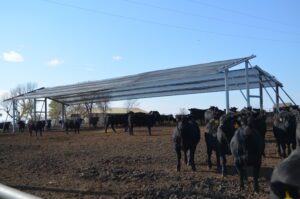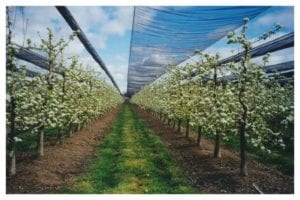Durable Shade Houses Engineered to Last
Optimize plant growth and protect crops with a custom-designed shade house. Our shade house structures are engineered to withstand storms and wind uplift so you can rest easy knowing your plants are protected from the elements.

Why Choose Our Shade House Structures?
- Custom heights and interior pole spacing
- Galvanized steel poles with anchor bases to resist uplift
- Multi-layer designs mimic seasonal shade requirements
- Easy integration of perimeter wind or security fencing
- UV-optimized coloured fabrics to control light spectrum and intensity to promote plant growth

Designed to Last
Our shade houses are designed with you in mind. We understand that many rural areas accept lower standards for agricultural buildings, referring to them as “temporary” or “low risk”. Sure, they may be a “low risk” to the general public, but are they low risk to you?
When Hurricanes Frances and Jeanne blew through Southern Florida, many shade houses were destroyed while our shade house structures remained virtually untouched. We are committed to designing durable and reliable structures so you can rest assured knowing that your shade protection can withstand even the toughest storms.
The increase in cost for a well designed and constructed shade house is small, and the financial savings after a big storm more than make up the difference.

Here’s why:
Smart Design. Stronger Results.
Our shade house structures feature:
- Swivel pole-tops that attach to side poles allowing for quick and easy retraction of the canopy
- Tensioned cables & taut fabric to minimize flapping
- Reduced wind load on crops and greenhouses under the canopy
Winterizing Options for Year-Round Protection
Those in agricultural know that winterizing growing environments is critical. For some crops, trapping heat during the colder seasons can mean the difference between healthy growth and complete crop loss. All of our plant shade houses are equipped with fully retractable panels to provide year-round protection.

Flexible Sizes to Match Your Shade House Needs
- Height: 10ft to 30ft (3m-9m)
- Coverage Area: 0.5 acres – 50 acres (0.2ha – 20ha)
- Pole Spacing: Spacings can be adjusted to suit. On lower houses is usually more economical to have poles on a grid of approximately 24ft (8m) but spans of 100ft (30m) are available if needed

What makes a Shade house Strong?
Poor construction can cost more than just the replacement value. You must also consider the loss of specialized root-stock, the loss of plants to sun if the fabric has blown away and cannot be quickly replaced, and the loss of markets that look elsewhere for their supply. Growers with poor shade houses for plants also talk about the loss of sleep every time there is a moderate storm- will their shade house be there in the morning?
This does not need to be you.
Shade house strength comes down to the 3 F’s: Foundations. Fabric. Fatigue.
Foundations
- Good anchors are deep with large plates to resist wind uplift
Fabric
- Forget traditional grommets, our fabric hem system captures almost all the yarns at the edge connections to increase shade house structure longevity and strength
Fatigue
- Tautly installed cables and fabric prevent sagging, flapping, and failure to keep your structure performing optimally no matter the season
Want the full breakdown?
Download the complete Shade House Strength Guide and get expert insights on building a better, tougher shade solution.
Download the Shade Strength Guide here
This article was written in response to queries after Hurricanes Frances and Jeanne wrecked a number of shade house in South Florida, but had virtually no effect on WeatherSolve shade house






